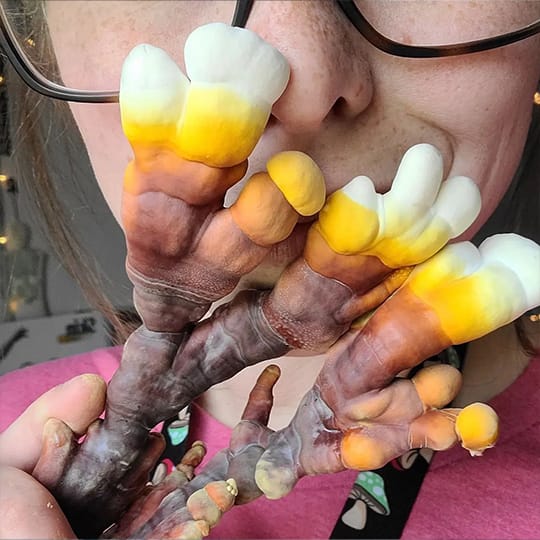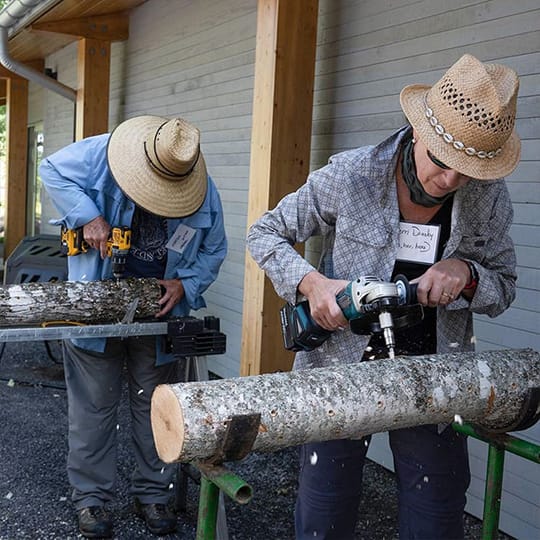





| Skill level | Intermediate |
| Grow location | Indoors |
| Spawn shelf life | 4 months (refrigerated) |
| Certifications | USDA certified organic |
| Bag weight | 6 lbs |
| Fruiting temps | 50-65°F |
Our Golden Enoki (Flammulina velutipes) grain spawn features a cultivated strain that produces elegant clusters of slender, golden-yellow mushrooms with long, threadlike stems and petite button-like caps. A staple in East Asian cuisine, Golden Enoki offers a crisp texture and mild, slightly fruity flavor that deepens when cooked—perfect for soups, stir-fries, and hot pots.
Golden Enoki is a rewarding indoor variety, particularly suited to cooler temperatures and high humidity. When grown under the right conditions, it can produce generous first and second flushes, making it a great option for small-scale commercial growers and serious home cultivators alike. Though more cold-tolerant than tropical oysters, Golden Enoki prefers stable environmental control for best results.
Golden Enoki grain spawn is ideal for indoor cultivation and should be kept out of direct sunlight and dry environments. It may fruit outdoors in spring or fall in cooler regions, but it is best known for its performance indoors under controlled conditions.
Recommended Use:
Golden Enoki grain spawn can be used for indoor production using supplemented sawdust blocks or sterilized straw. It is also suitable for growing in containers or controlled environment grow rooms.
- Do not use grain spawn for log inoculation.
- This is not a mushroom grow kit. Golden Enoki grain spawn must be combined with a substrate in order to fruit.
Upon Receiving Your Spawn:
Remove it from the shipping box as soon as possible. Then, unfold the top of the bag to allow for air space. Ensure the filter patch is unobstructed to maintain airflow—this is crucial for the mycelium to breathe and stay healthy until you're ready to inoculate.
Scroll down for specifications, growing, and storage guides.
-
- Weight: Approximately 6 lbs
- Hydration: Average of 47%
- Bags: Gusseted 2.2 mil polypropylene
- Filter: High efficiency .2 micron
- Inoculation Rates: 6 lb. bag of grain will inoculate between 120-165 lb. sterilized sawdust
- Sterilization method: Commercial grade autoclave sterilized
-
Temperature 45-65°F | 7-18°C Humidity (Phase 1: Primordia) 98-100% Humidity (Phase 2: Fruitbody) 88-95% CO2 Sensitivity (Phase 1: Primordia) 500-1,000 ppm CO2 Sensitivity (Phase 2: Fruitbody) <1,000 ppm - Primordia - The earliest recognizable stage of fruitbody development. Also known as “baby mushrooms” or “mushroom pins.”
- Fruitbody - A fully grown mushroom, the reproductive structure of the organism in which the spores are produced.
- CO2 sensitivity - When CO2 levels are too high, yields will decrease, stems will become long and stringy, caps will be small, and/or growth will halt.
-
Golden Enoki mushroom grain spawn can be mixed into sterilized hardwood sawdust to create Golden Enoki substrate blocks.
CLICK HERE for full details.
Note: Grain spawn must be mixed with bulk substrate before you can fruit it. If you are new to growing mushrooms, we recommend purchasing a book on mushroom cultivation.
Recommended reading:
'Growing Gourmet and Medicinal Mushrooms' by Paul Stamets
'Organic Mushroom Farming and Mycoremediation' by Tradd Cotter
-
If you don't plan to use immediately, you can refrigerate your spawn for up to 4 months.
-
Our grain spawn is USDA certified organic and made using organic cultures from our own culture bank. It contains a blend of locally sourced, organic, and non-GMO grains and supplements from farms in New England and North America.
-
If you’re going to consume home-grown mushrooms, make sure to cook your fresh mushrooms thoroughly with heat. If it is your first time eating this species, it is best to start with a small amount to check for allergies, even if cooked.
-
CLICK HERE for instructions
You may also like
Making the world of mushrooms accessible to all
North Spore was launched in 2014 by a mycologist, an organic farmer, and a photojournalist -- three college friends brought together through their shared love of the mycological world.
What began as a simple love for mushroom foraging and cultivation quickly developed into an obsession with all things fungi. From there, an urban mushroom farm was born, as was the desire to spread the spore to the masses.













